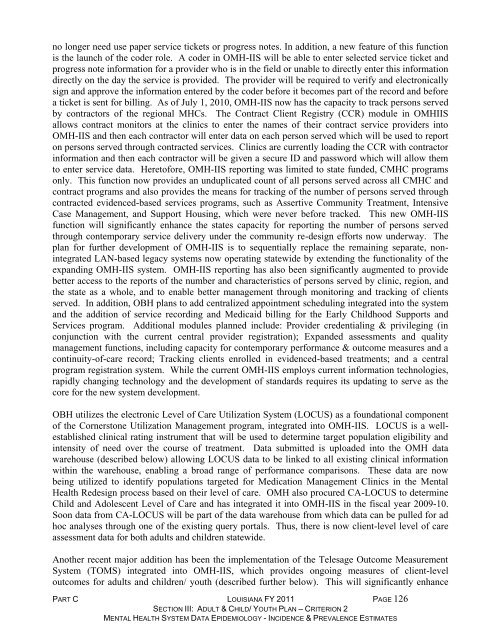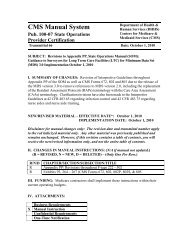LOUISIANA Community Mental Health Services Block Grant ...
LOUISIANA Community Mental Health Services Block Grant ...
LOUISIANA Community Mental Health Services Block Grant ...
You also want an ePaper? Increase the reach of your titles
YUMPU automatically turns print PDFs into web optimized ePapers that Google loves.
no longer need use paper service tickets or progress notes. In addition, a new feature of this function<br />
is the launch of the coder role. A coder in OMH-IIS will be able to enter selected service ticket and<br />
progress note information for a provider who is in the field or unable to directly enter this information<br />
directly on the day the service is provided. The provider will be required to verify and electronically<br />
sign and approve the information entered by the coder before it becomes part of the record and before<br />
a ticket is sent for billing. As of July 1, 2010, OMH-IIS now has the capacity to track persons served<br />
by contractors of the regional MHCs. The Contract Client Registry (CCR) module in OMHIIS<br />
allows contract monitors at the clinics to enter the names of their contract service providers into<br />
OMH-IIS and then each contractor will enter data on each person served which will be used to report<br />
on persons served through contracted services. Clinics are currently loading the CCR with contractor<br />
information and then each contractor will be given a secure ID and password which will allow them<br />
to enter service data. Heretofore, OMH-IIS reporting was limited to state funded, CMHC programs<br />
only. This function now provides an unduplicated count of all persons served across all CMHC and<br />
contract programs and also provides the means for tracking of the number of persons served through<br />
contracted evidenced-based services programs, such as Assertive <strong>Community</strong> Treatment, Intensive<br />
Case Management, and Support Housing, which were never before tracked. This new OMH-IIS<br />
function will significantly enhance the states capacity for reporting the number of persons served<br />
through contemporary service delivery under the community re-design efforts now underway. The<br />
plan for further development of OMH-IIS is to sequentially replace the remaining separate, nonintegrated<br />
LAN-based legacy systems now operating statewide by extending the functionality of the<br />
expanding OMH-IIS system. OMH-IIS reporting has also been significantly augmented to provide<br />
better access to the reports of the number and characteristics of persons served by clinic, region, and<br />
the state as a whole, and to enable better management through monitoring and tracking of clients<br />
served. In addition, OBH plans to add centralized appointment scheduling integrated into the system<br />
and the addition of service recording and Medicaid billing for the Early Childhood Supports and<br />
<strong>Services</strong> program. Additional modules planned include: Provider credentialing & privileging (in<br />
conjunction with the current central provider registration); Expanded assessments and quality<br />
management functions, including capacity for contemporary performance & outcome measures and a<br />
continuity-of-care record; Tracking clients enrolled in evidenced-based treatments; and a central<br />
program registration system. While the current OMH-IIS employs current information technologies,<br />
rapidly changing technology and the development of standards requires its updating to serve as the<br />
core for the new system development.<br />
OBH utilizes the electronic Level of Care Utilization System (LOCUS) as a foundational component<br />
of the Cornerstone Utilization Management program, integrated into OMH-IIS. LOCUS is a wellestablished<br />
clinical rating instrument that will be used to determine target population eligibility and<br />
intensity of need over the course of treatment. Data submitted is uploaded into the OMH data<br />
warehouse (described below) allowing LOCUS data to be linked to all existing clinical information<br />
within the warehouse, enabling a broad range of performance comparisons. These data are now<br />
being utilized to identify populations targeted for Medication Management Clinics in the <strong>Mental</strong><br />
<strong>Health</strong> Redesign process based on their level of care. OMH also procured CA-LOCUS to determine<br />
Child and Adolescent Level of Care and has integrated it into OMH-IIS in the fiscal year 2009-10.<br />
Soon data from CA-LOCUS will be part of the data warehouse from which data can be pulled for ad<br />
hoc analyses through one of the existing query portals. Thus, there is now client-level level of care<br />
assessment data for both adults and children statewide.<br />
Another recent major addition has been the implementation of the Telesage Outcome Measurement<br />
System (TOMS) integrated into OMH-IIS, which provides ongoing measures of client-level<br />
outcomes for adults and children/ youth (described further below). This will significantly enhance<br />
PART C <strong>LOUISIANA</strong> FY 2011 PAGE 126<br />
SECTION III: ADULT & CHILD/ YOUTH PLAN – CRITERION 2<br />
MENTAL HEALTH SYSTEM DATA EPIDEMIOLOGY - INCIDENCE & PREVALENCE ESTIMATES
















